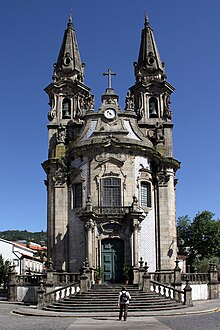| Santos Passos Church | |
|---|---|
| Igreja de Nossa Senhora da Consolação e dos Santos Passos | |
| Igreja de São Guálter (Saint Guálter Church) | |
Igreja dos Santos Passos | |
 The Santos Passos Church in 2012 | |
 | |
| 41°26′27″N 8°17′23″W / 41.44083°N 8.28972°W | |
| Location | Campo da Feira, HCG, Guimarães |
| Country | Portugal |
| Denomination | Catholic |
| History | |
| Status | Protected (Public Interest Building),[1] inserted in the HCG.[2] |
| Architecture | |
| Architect(s) |
|
| Style | Portuguese baroque with Rococo influences |
| Years built |
|
| Specifications | |
| Number of towers | 2 |
| Administration | |
| Archdiocese | Roman Catholic Archdiocese of Braga |
The Santos Passos Church (Portuguese: Igreja dos Santos Passos), officially called Igreja de Nossa Senhora da Consolação e dos Santos Passos[3] and sometimes referred to as Igreja de São Gualter,[4] is an 18th-century Portuguese baroque Catholic church located at the Campo da Feira in Guimarães, Portugal.
Constructed to replace the dilapidated chapel which had previously occupied the same site, the Santos Passos Church and its five oratories, which depict the Passion of Jesus, were designated a protected landmark by the Portuguese government in 1993. It also falls within the Historic Centre of Guimarães, a UNESCO World Heritage Site since 2001. The church plays a significant role in many of the festivities and religious celebrations of Guimarães.
- ^ "Igreja e Oratórios de Nossa Senhora da Consolação". servicos.dgpc.gov.pt (in Portuguese). Archived from the original on 14 July 2023. Retrieved 25 February 2024.
- ^ Cite error: The named reference
:13was invoked but never defined (see the help page). - ^ "Igreja e Oratórios de Nossa Senhora da Consolação e dos Santos Passos". em.guimaraes.pt. Archived from the original on 2 July 2024. Retrieved 2 July 2024.
- ^ "Igreja e oratórios de Nossa Senhora da Consolação / Igreja de São Gualter". www.monumentos.gov.pt (in European Portuguese). Archived from the original on 23 February 2024. Retrieved 26 February 2024.
